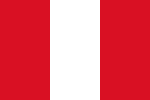On Transparency International's 2023 Corruption Perceptions Index, Peru scored 33 on a scale from 0 ("highly corrupt") to 100 ("very clean"). When ranked by score, Peru ranked 121st among the 180 countries in the Index, where the country ranked first is perceived to have the most honest public sector. For comparison with worldwide scores, the best score was 90 (ranked 1), the average score was 43, and the worst score was 11 (ranked 180). For comparison with regional scores, the highest score among the countries of the Americas was 76, the average score was 43 and the lowest score was 13.
According to the 2021 AmericasBarometer survey of the Latin American Public Opinion Project (LAPOP), 88% of Peruvians believe that half to all politicians in the nation are corrupt, the highest percentage in Latin America according to the study.
History
Fujimori government
Peru's most prominent political corruption scandal is probably the case of Alberto Fujimori, Peru's President from 1990 to 2000. In 2000, Fujimori resigned and fled to Japan. He returned from Japan in 2005 and in April 2009 was sentenced to 25 years in prison for authorizing murders by death squads and for two kidnappings.
During his rule, Fujimori helped to maintain the government's image of honesty by using his advisor, Vladimiro Montesinos, to carry out the administration's corrupt procedures. Montesinos served as the head of the National Intelligence Service (SIN) where he systematically bribed politicians, judges, and the news media. An empirical analysis of Montesinos' corruption conducted by John McMillan and Pablo Zoido describes how Montesinos used over 75% of SIN's unsupervised budget to bribe over 1,600 individuals. McMillan and Zoido estimate that at the height of the scandal more than U.S.$3.5 million was being paid monthly to various congressmen, judges and media executives. The most common bribes were paid to television-channel owners which allowed Fujimori's administration to control the media and politically influence Peruvians.
Recent history
After further scandals and facing a second impeachment vote, Pedro Kuczynski, his successor, resigned the presidency on 21 March 2018 following the release of videos showing alleged acts of vote buying, presenting his resignation to the Council of Ministers. As a result of the Odebrecht scandal and other controversies, in 2018 all of Peru's living former presidents were either imprisoned or the focus of corruption investigations.
Bribery
Irregular payments and bribes are often demanded from companies operating in Peru, and government contracts are often awarded to well-connected companies. Many companies experience the demand for facilitation payments as a result of Peru's extensive bureaucracy.
See also
- Crime in Peru
- International Anti-Corruption Academy
- Group of States Against Corruption
- International Anti-Corruption Day
- ISO 37001 Anti-bribery management systems
- United Nations Convention against Corruption
- OECD Anti-Bribery Convention
- Transparency International
Notes
- Argentina, Bahamas, Barbados, Bolivia, Brazil, Canada, Chile, Colombia, Costa Rica, Cuba, Dominica, Dominican Republic, Ecuador, El Salvador, Grenada, Guatemala, Guyana, Haiti, Honduras, Jamaica, Mexico, Nicaragua, Panama, Paraguay, Peru, Saint Lucia, Saint Vincent and the Grenadines, Suriname, Trinidad and Tobago, United States, Uruguay, Venezuela
References
- "The ABCs of the CPI: How the Corruption Perceptions Index is calculated". Transparency.org. 20 December 2021. Retrieved 23 April 2024.
- "Corruption Perceptions Index 2023: Peru". Transparency.org. Retrieved 23 April 2024.
- "Corruption Perceptions Index 2023: Americas". Transparency.org. CPI2023_Map_Americas_EN.pdf. Retrieved 23 April 2024.
- "'Essential ingredient' for halting corruption in Peru? Common good". Christian Science Monitor. ISSN 0882-7729. Retrieved 2023-03-06.
- "Freedom in the World- Peru". Freedom House. Archived from the original on 28 April 2017. Retrieved 18 July 2023.
- McMillan, John, and Pablo Zoido (2004). How to Subvert Democracy: Montesinos in Peru. Journal of Economic Perspectives 18.4 (2004): 70
- McMillan, John, and Pablo Zoido (2004). How to Subvert Democracy: Montesinos in Peru. Journal of Economic Perspectives 18.4 (2004): 70
- McMillan, John, and Pablo Zoido (2004). How to Subvert Democracy: Montesinos in Peru. Journal of Economic Perspectives 18.4 (2004): 73
- McMillan, John, and Pablo Zoido (2004). How to Subvert Democracy: Montesinos in Peru. Journal of Economic Perspectives 18.4 (2004): 82
- McMillan, John, and Pablo Zoido (2004). How to Subvert Democracy: Montesinos in Peru. Journal of Economic Perspectives 18.4 (2004): 70
- "PPK renunció a la presidencia del Perú tras 'keikovideos'" [PPK resigned from the presidency of Peru after 'keikovideos']. La República (in Spanish). 21 March 2018. Retrieved 21 March 2018.
- "PPK renunció a la presidencia del Perú" [PPK resigned from the presidency of Peru]. Gestión (in Spanish). 21 March 2018. Retrieved 21 March 2018.
- "LatAm in Focus: Why Peru's Political Establishment Is Scared". Council of the Americas. Retrieved 2018-10-12.
- "Peru Corruption Profile". Business Anti-Corruption Portal. Retrieved 14 July 2015.
External links
- Peru Corruption Profile from the Business Anti-Corruption Portal
| Corruption in South America | |
|---|---|
| Sovereign states | |
| Dependencies and other territories | |
